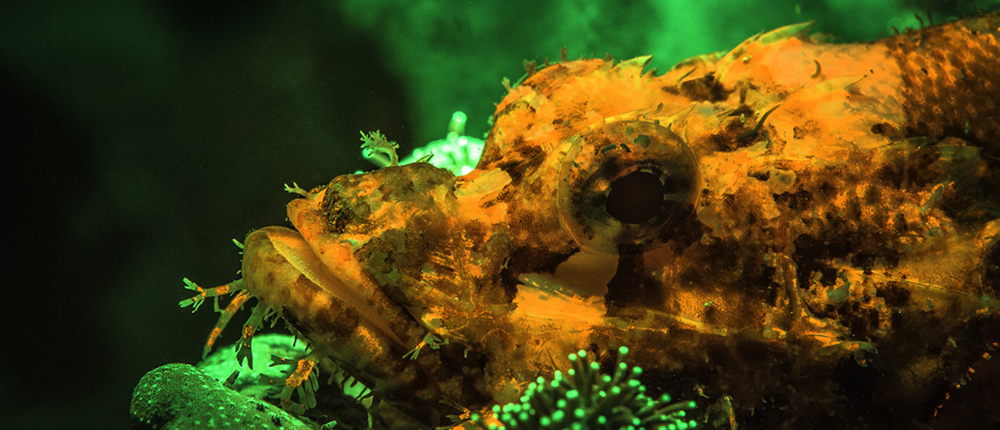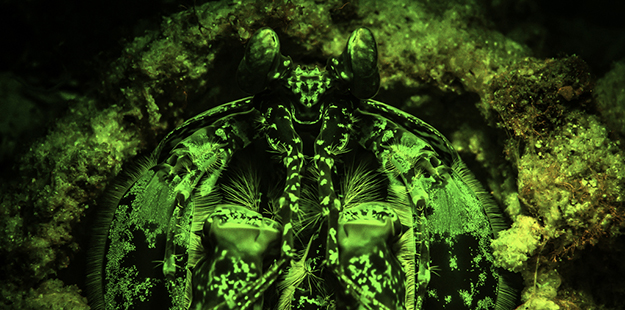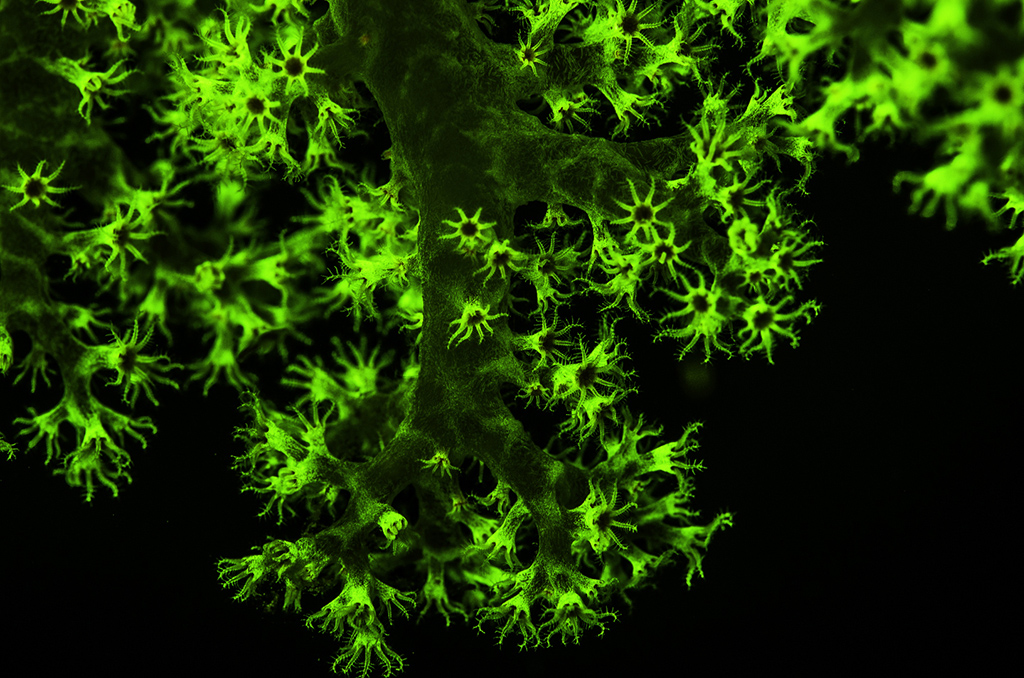Diving in a Whole New Light
Scuba diving is a visual sport. Whether it’s seeking out small creatures among the hidden crevices of a coral head, or admiring the majestic vista of a vertical wall, the eyes have it… or so it seems. It turns out that fish and other marine life have the ability to reflect light in spectrums that are not visible to the human eye but can be revealed through the use of special lighting. Fluo diving at Wakatobi is an experience not to miss.
A phenomenal glow
This phenomenon is known as marine fluorescence, and it allows certain forms of marine life to glow in a range of unique colors that seem to come from within. Not to be confused with phosphorescence, or bio-luminescence, fluorescence occurs when an object absorbs the energy from one wavelength of light and re-emits a totally different color. When a fluorescent object is seen under sunlight, it appears normal. But when struck by a near-UV light source, it absorbs the blue light spectrum and re-emits a fluorescence of an entirely different color. This is similar to how a “black light” poster or painting transforms when an ultra-violet lamp is used to light it up.

Fluorescing Orangutan crab on a sponge at Zoo, a popular Wakatobi fluo dive site. Photo by Walt Stearns
One of the best places in the world to observe marine florescence is on the reefs of Wakatobi. Not only did the resort pioneer the practice that his now known as Fluo-Diving, it also the ideal environment to see and experience this phenomenon first hand. Wakatobi’s reefs are among the healthiest and most diverse on the planet, and are rich in the creatures that reveal their hidden nature through fluorescence.
Pioneering Fluo Diving
Scientists first began studying marine florescence in the 1970s, but it was not until very recently that the principles were applied to recreational diving. Fluo-diving was pioneered at Wakatobi Dive Resort. It began when underwater filmmakers Guy and Anita Chaumette of Liquid Motion Films, documented the fluorescent qualities of Wakatobi’s marine life and introduced the experience at Wakatobi Dive Resort. Their award-winning series ‘Water Colours’ included an episode titled Beyond the Blue, which revealed the unique phenomenon of marine fluorescence, and documented the integral role fluorescence plays in marine animals’ daily lives.
“The odds of you going in the water and finding something, seeing some animal fluorescing, that no-one else in the entire history of the universe has ever seen is probably over ninety percent! Anywhere in the world, simply because so few people have done this.”
The couple used the special technology and know-how learned from working with leading research scientists to develop a unique dive experience that we share with resort guests. Done at night, these unique guided dive and snorkels are made using a special type of light and mask filter that reveals the hidden fluorescent colors of the reef.
According to Dr. Charles Mazel Ph.D, a leading fluorescence research scientist and the inventor of fluotechnology, “The odds of you going in the water and finding something, seeing some animal fluorescing, that no-one else in the entire history of the universe has ever seen is probably over ninety percent! Anywhere in the world, simply because so few people have done this.”
Underwater fluorescence is seen at night, when there is no sunlight. Instead of conventional dive lights, fluo-divers (and fluo-snorkelers) are given special blue lights, along with yellow filters that fit over the dive mask. When the beams of these lights are swept along a reef, certain corals and animals light up as if a switch were flipped on.
Scientists still aren’t completely sure why marine organisms fluoresce. Some think corals use it to protect themselves or their algae colonies from harsh light or bleaching, while others theorize that it may aid photosynthesis in darker, light-limited environments. When fluorescence appears in fish, it is thought to be related to communication. It is well known that fish use color as their primary means of communication; their colors and patterns are used to attract mates, evade predators and stalk prey. One explanation comes from Dr. Justin Marshall, a marine biologist specializing in marine color signals and changes. “For animals on the reef, being colorful is really about wanting to say something” he says. “They’re using fluorescence as part of their color communication channel. It’s a way of being even more colorful.”
Back to premier ocean discovery
In addition to the visually exciting aspects of fluo-diving, there’s the distinct possibility of discovery. Because this phenomenon is relatively new to the scientific and diving communities, new discoveries are made on a regular basis, and on any given dive, there’s a chance to observe a new type of fluorescent behavior or reveal a previously-unknown species. For example, during a recent NOAA expedition, researches working in very deep water came across a fluorescent shark.
Wakatobi founder Lorenz Mäder considers his first experience with fluo-diving to be one of his most memorable dives. “Having seen the underwater fluorescence movies of Anita and Guy, I was burning to see this exciting new effect with my own eyes,” he says. “Taking my teenage daughter along for a thrilling lesson in physics made it even more fun. Gliding over the reef top, hidden animals in screaming bright fluorescent colors were suddenly easy to spot – we felt like 007 with a secret weapon.”
“The familiar house reef wowed us with glowing organisms such as soft corals, hard corals, fish, snails and others,” Mäder recalls. “I noted that some corals were glowing, while others of the same species were not; some hard corals would even show different patterns in individual corals of the same species. One really cool discovery was that the pygmy seahorses show fluorescence and easily stood out on the fans. There is much more to explore, and no explanations yet for these phenomena.”
Fluo-dives and snorkels are conducted with a private guide as a one-on-one or buddy-diving experience. Guests of Wakatobi Dive Resort can make arrangements with the resort staff or the concierge.
For more information on a Wakatobi trip with Fluo-diving / Snorkeling, complete our trip inquiry form on www.wakatobi.com. Or email our office: office@wakatobi.com.





